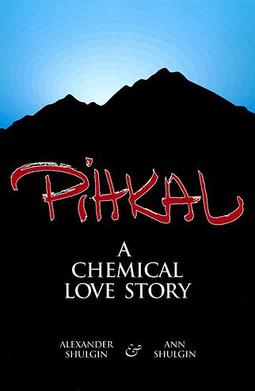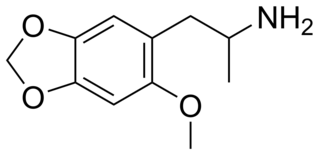
PiHKAL: A Chemical Love Story is a book by Dr. Alexander Shulgin and Ann Shulgin, published in 1991. The subject of the work is psychoactive phenethylamine chemical derivatives, notably those that act as psychedelics and/or empathogen-entactogens. The main title, PiHKAL, is an acronym that stands for "Phenethylamines I Have Known and Loved."

para-Methoxyamphetamine (PMA), also known as 4-methoxyamphetamine (4-MA), is a designer drug of the amphetamine class with serotonergic effects. Unlike other similar drugs of this family, PMA does not produce stimulant, euphoriant, or entactogen effects, and behaves more like an antidepressant in comparison, though it does have some psychedelic properties.

2,5-Dimethoxy-4-ethylamphetamine is a psychedelic drug of the phenethylamine and amphetamine chemical classes. It was first synthesized by Alexander Shulgin, and was described in his book PiHKAL.

3,4-Methylenedioxy-N-methoxyamphetamine is a lesser-known psychedelic drug and a substituted amphetamine. It is also the N-methoxy analogue of MDA. MDMEO was first synthesized by Alexander Shulgin. In his book PiHKAL , the minimum dosage is listed as 180 mg. MDMEO may be found as white crystals. It produces few to no effects. Very little data exists about the pharmacological properties, metabolism, and toxicity of MDMEO.
Dimethoxyamphetamine (DMA) is a series of six lesser-known psychedelic drugs similar in structure to the three isomers of methoxyamphetamine and six isomers of trimethoxyamphetamine. The isomers are 2,3-DMA, 2,4-DMA, 2,5-DMA, 2,6-DMA, 3,4-DMA, and 3,5-DMA. Three of the isomers were characterized by Alexander Shulgin in his book PiHKAL. Little is known about their dangers or toxicity.

2,5-Dimethoxy-4-ethoxyamphetamine (MEM) is a psychedelic drug of the phenethylamine and amphetamine chemical classes. It was first synthesized by Alexander Shulgin. In his book PiHKAL, he lists the active dose range as 20–50 mg, and the duration as 10–14 hours. According to Shulgin, MEM produces color enhancement, visual phenomena, and pattern movement, among other effects.
TOM, or methylthio-methyl-methoxyamphetamine, is a series of lesser-known psychedelic drugs and substituted amphetamines with the molecular formula C12H19NOS. 2-TOM and 5-TOM are the 2- and 5-methylthio analogs of 2,5-dimethoxy-4-methylamphetamine (DOM), respectively. They were first synthesized by Alexander Shulgin and described in his book PiHKAL. Very little is known about their dangers or toxicity.
TOET (methylthio-ethyl-methoxyamphetamines) is a pair of lesser-known psychedelic drugs and substituted amphetamines. 2-TOET and 5-TOET are the 2- and 5-methylthio analogs of DOET, respectively. They were first synthesized by Alexander Shulgin and written up in his book PiHKAL. Very little is known about their dangers or toxicity.

para-Methoxy-N-methylamphetamine, chemically known as methyl-MA, 4-methoxy-N-methylamphetamine, 4-MMA) or is a stimulant and psychedelic drug closely related to the amphetamine-class serotonergic drug para-methoxyamphetamine (PMA). PMMA is the 4-methoxy analog of methamphetamine. Little is known about the pharmacological properties, metabolism, and toxicity of PMMA; because of its structural similarity to PMA, which has known toxicity in humans, it is thought to have considerable potential to cause harmful side effects or death in overdose. In the early 2010s, a number of deaths in users of the drug MDMA were linked to misrepresented tablets and capsules of PMMA.

para-Methoxyethylamphetamine (PMEA), is a stimulant drug related to PMA. PMEA reputedly produces similar effects to PMA, but is considerably less potent and seems to have slightly less tendency to produce severe hyperthermia, at least at low doses. At higher doses however the side effects and danger of death approach those of PMA itself, and PMEA should still be considered a potentially dangerous drug. Investigation of a drug-related death in Japan in 2005 showed PMEA to be present in the body and was thought to be responsible for the death.

MMDA-2 (2-methoxy-4,5-methylenedioxyamphetamine) is a psychedelic drug of the amphetamine class. It is closely related to MMDA and MDA.

Methoxyphenamine, also known as 2-methoxy-N-methylamphetamine (OMMA), is a β-adrenergic receptor agonist of the amphetamine class used as a bronchodilator.

3-Methoxy-4-methylamphetamine (MMA) is an entactogen and psychedelic drug of the phenethylamine and amphetamine classes. It was first synthesized in 1970 and was encountered as a street drug in Italy in the same decade. MMA was largely forgotten until being reassayed by David E. Nichols as a non-neurotoxic MDMA analogue in 1991, and has subsequently been sold as a designer drug on the internet since the late 2000s (decade).
A serotonin releasing agent (SRA) is a type of drug that induces the release of serotonin into the neuronal synaptic cleft. A selective serotonin releasing agent (SSRA) is an SRA with less significant or no efficacy in producing neurotransmitter efflux at other types of monoamine neurons.

para-Ethoxyamphetamine, also known as 4-ethoxyamphetamine (4-ETA), is a psychoactive drug and research chemical of the phenethylamine and amphetamine chemical classes which is closely related to the infamous para-methoxyamphetamine (PMA). para-Ethoxyamphetamine has similar effects to PMA in animal studies, although with slightly weaker stimulant effects. Like PMA, it has prominent MAOI activity, and is likely to have similar dangers associated with its use.

meta-Methoxyamphetamine (MMA), also known as 3-methoxyamphetamine (3-MA), is a stimulant drug from the amphetamine family. It has similar effects in animal drug discrimination tests to the more widely known derivative 4-methoxyamphetamine (PMA), although with a slightly different ratio of monoamine release, being a combined serotonin, dopamine, and norepinephrine releasing agent rather than a fairly selective serotonin releaser like PMA. 3-Methoxyamphetamine has similarly appeared on the illicit market as a designer drug alternative to MDMA, although far more rarely than its infamous positional isomer. It produces gepefrine, a cardiac stimulant, as one of its major metabolites.

3-Methoxymethamphetamine, which is most closely related to 3-methoxyamphetamine and PMMA and shares similar monoamine releasing effects, although its effects have not been studied so extensively as other related drugs. It is an agonist of human TAAR1.
Substituted amphetamines are a class of compounds based upon the amphetamine structure; it includes all derivative compounds which are formed by replacing, or substituting, one or more hydrogen atoms in the amphetamine core structure with substituents. The compounds in this class span a variety of pharmacological subclasses, including stimulants, empathogens, and hallucinogens, among others. Examples of substituted amphetamines are amphetamine (itself), methamphetamine, ephedrine, cathinone, phentermine, mephentermine, tranylcypromine, bupropion, methoxyphenamine, selegiline, amfepramone (diethylpropion), pyrovalerone, MDMA (ecstasy), and DOM (STP).

6-(2-Aminopropyl)tetralin (6-APT), also sometimes called tetralinylaminopropane (TAP), is a drug of the amphetamine class which acts as a selective serotonin releasing agent (SSRA). It has IC50 values of 121 nM, 6,436 nM, and 3,371 nM for inhibiting the reuptake of serotonin, dopamine, and norepinephrine, respectively. Though it possesses an appreciable in vitro profile, in animal drug discrimination studies it was not found to substitute for MMAI or amphetamine and to only partially substitute for MBDB. This parallels Alexander Shulgin's finding that EDMA (the 1,4-benzodioxine analogue of 6-APT) is inactive, and appears to indicate that the pharmacokinetics of both EDMA and 6-APT may not be favorable.














